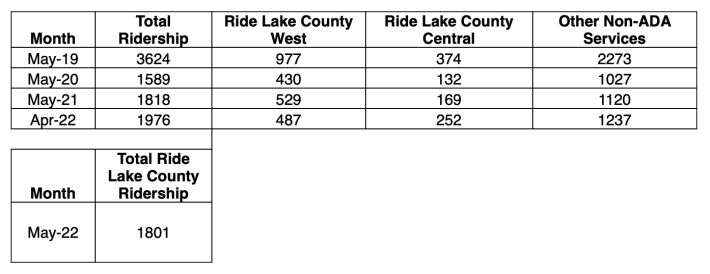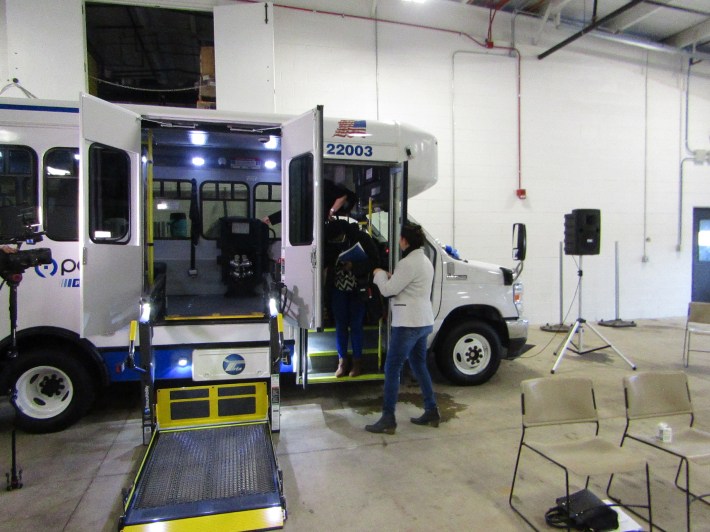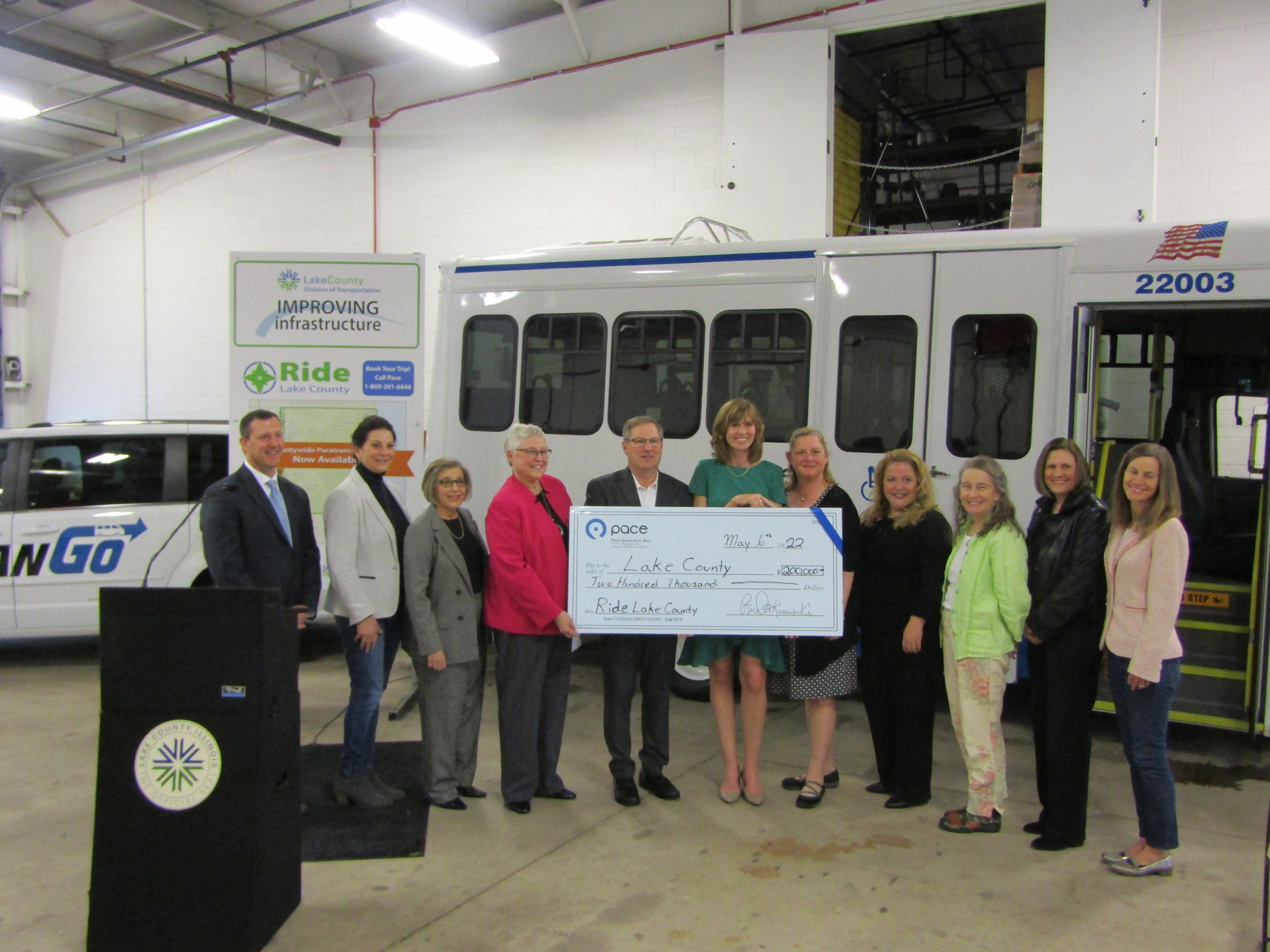Ride Lake County, a county-wide dial dial-a-ride bus service for seniors and people with disabilities got off to a modest start after it debuted in May, drawing slightly fewer riders than the patchwork of dial-a-ride services it replaced – but at least some of that may be due to the more streamlined nature of the service that requires fewer transfers.
Operated by Pace suburban bus transit agency and the Lake County Division of Transportation, Ride Lake County replaced multiple providers that had different service areas, reservation systems, fare structures and eligibility requirements. The services were meant to supplement Pace and Metra service and provide more direct door-to-door, on-demand service mostly (but not always exclusively) for seniors and/or people with disabilities – but the patchwork nature of the system made longer-distance travel difficult. Consolidating dial-a-ride systems has been a long-term priority for Pace and accessibility advocates for years. The 2022 Pace budget gave each county a $200,000 grant to create a county-wide system, while also increasing Pace’s funding by 15 percent.
In some respects, Ride Lake County resembles McHenry County’s MCRide. Both provide services within the entirety of their respective countries, as well as in municipalities that are partially in their respective counties (for example, both serve Fox River Grove, which spans both counties, and Ride Lake County serves both the Cook County and Lake County portions of Wheeling). Both have distance-based fare systems, though Ride Lake County caps the fares at $6. However, unlike MCRide, Ride Lake County isn’t open to the general public. And, on a positive side, Ride Lake County became the Chicago area’s first dial-a-ride service to have buses with USB-based chargers and onboard Wi-Fi.
On May 6, Pace and county officials held a launch event at Division of Transportation’s garage, touting the benefits of consolidation and showing off one of the new paratransit buses.

According to Pace data, Ride Lake County had 1,801 riders in May, which is slightly less than the 1,976 riders that used all Lake County dial-a-ride systems in April. Pace provided the ridership numbers for the last three Mays, but given that we are still dealing with the pandemic and the effects of the pandemic were more pronounced in May 2021 and 2020, it’s hard to do apple-to-apple comparisons. Furthermore, it’s not clear how many of the April trips involved transfers between services. Since riders had to pay full fares every times they switched, it’s possible that some trips were counted multiple times.
Service Overview
Traditionally, each dial-a-ride service has been operated by a sponsoring organization – usually a municipality, a township, or a nonprofit. Pace provides the vehicle and covers the portion of the funding, but each sponsoring organization sets its own rules for who gets to ride it, how much they pay and what the service area is.
A look at the old Lake County dial-a-ride provider page highlights the shortcomings of this approach. Some services didn’t go past a town/township, while others span several townships. Some only served seniors, some only served people with disabilities, some served both, and four served all riders. Fares were anywhere from $1 to $3, hours varied wildly, most didn’t run on weekends and each system had its own process for reserving trips.
During the May 6 event, Lake County Board Chair and District 13 Commissioner Sandy Hart, whose district goes diagonally across the southeastern portion of the county, said she saw the effects this lack of coordination had on some of her most vulnerable constituents.
“A young man in my district had to take multiple buses to get to work,” she said. “While [providers] tried, on several different occasions, to work for him, unfortunately, he had to quit the job that he loved, where he made many friends and was proud of the work he was doing, because he didn’t have the transportation to get there.”
Hart noted that, while the county used to believe that dial-a-ride systems were primarily used for trips to grocery stores and medical appointments, its 2019 market study found that about half of dial-a-ride users used the services to get to work.
Ride Lake County creates a single reservation system and a unified fare structure. All riders pay $2.00 for trips that are 5 miles or less, $4.00 for trips between 5.01 and 10 miles, and $6.00 for trips longer than 10 miles. By comparison, MCRide charges the general public $3 and seniors and people with disabilities $1.50 for the first eight miles, and $0.25 for each additional mile. There is no transfer fare for riders switching to other dial-a-ride services or any Pace fixed routes.
While most previous Lake County dial-a-ride services required riders to call at least a day ahead of time, Ride Lake County riders can call as little as two hours ahead of time. The service operates between 6:00 a.m. and 6:00 p.m. – an improvement compared to most services, though a downgrade for a handful that ran later. In a noticeable upgrade, it provides weekend service all across the board.
Mike Klemens, Lake County’s Manager of Transportation Planning, said that Pace is covering around $600,000 of the service operations, with the county covering between $600,000 to $1 million, depending on how much revenue comes from fares. The service also gets federal funding distributed by RTA.
While the consolidation is a net gain for seniors and people with disabilities, it did reduce service for general public. In Lake County, Pace doesn’t have much service outside Waukegan, Highland Park and its immediate neighbors, as well as several of its major corridors. Dial-a-ride services that accepted all riders filled in some of the gaps. Most notably, Ride Lake County West, which was sponsored by several western Lake County townships, provided service in the area that has little to no fixed-route Pace service – or, in case of Wauconda Township, no other transit service whatsoever.
Pace executive director Melinda Metzger said that the transit agency’s new VanGo car-sharing service, which launched in Lake County in June, will help make up for it. Riders will be able to reserve Pace-provided vans parked at Metra stations to travel to work. However, this isn’t helpful for riders who aren’t coming in by Metra – or riders who can’t drive (like this reporter).

Marking the launch
During the May 6 launch, Hart said she was “so excited that, after so many years of work, Ride Lake County has become a reality... We now have a seamless, borderless, [one reservation number] system in Lake County and, in some cases, beyond,” she said. “While there were once township boundaries [that forced riders] to switch buses, Ride Lake County is borderless.”
Pace board chair Richard Kwasneski said that creating Ride Lake County was a “monumental” task, but all the effort was worth it. “This effort has resulted in better transportation options for those we serve, and I applaud everyone involved,” he said.
Director Linda Soto, who represents Lake County on the Pace Board, believed that Ride Lake County would would help get more cars off the road. “[Ride Lake County] gets these people to work in quick, efficient, timely [manner],” she said. “It’s pleasant to use, safe to use, get them to school, get them to the doctor's office. And maybe they'd like to go to dinner or a movie, maybe they'd be able to do it.”
Since it was founded in 2005, Lake County Coordinated Transportation Services Committee has been a major force pushing for the county-wide dial-a-ride service consolidation. It persuaded the county to do a market study to demonstrate how important dial-a-ride services are and how consolidation would benefit everyone. With its mission accomplished, the committee dissolved itself in April, but LCCTSC chair Kathleen O’Connor was still on hand to mark the transition.
“I'm so happy to be here, because today is an important reminder of the celebration of what's possible,” O'Connor said. “Many thought that improving the paratransit service from one end of Lake County to the other was mission impossible. Ride Lake County is a wonderful example of how partnerships can lead to a more efficient use of public dollars, and how streamlining benefits our communities.”





